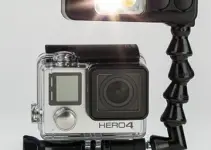As part of RED’s revamped product line, the GEMINI 5K is specifically designed for those video shooters who want to take advantage of the enhanced low light capabilities and dual native ISO the sensor provides. Since the camera is relatively new to the market, it’s interesting how well it actually performs in highly dimmed conditions.
Thankfully, Greg of LensProToGo provides an in-depth look into the video quality produced by the Gemini 5K at various ISOs. Beyond simply analyzing the quality of footage from the camera itself, the video below includes tests regarding exposure recovery at settings close to the native ISO values.
When looking at the Gemini 5K footage from the lowest ISO 250 to ISO 640, the image seems to be very clean with very little to no noise present across the board. The picture becomes a bit different when moving up to the first native ISO of 800 with a little bit of film grain introduced that can be observed here and there. Nonetheless, the aesthetic of the grain is still organic rather than digital and unpleasantly looking.
When we get into the low-light territory and ISO 1600, however, the grain becomes more prevalent, bordering the look of true digital noise, even though the image is still usable. At ISO 3200 more digital-looking green and magenta-tinted noise starts to emerge.
When set to ISO 5000, the footage from the Gemini 5K seems borderline usable. At this point, it would be hard to properly clean up the shot from the noise in the shadows and colored areas. At ISO 6,400 and 12,800, the noise and noticeable color shifts become even more apparent, especially in the shadow area of the image.
The next test conducted in the video refers to how well underexposed and overexposed footage can be corrected in post. First off, the camera was set to ISO 640, one set value below the native ISO 800.
The first series of tests dealt with underexposure. At one and two stops underexposed, the footage is easily recoverable with the exception of some digital noise present in darker areas of the image. At three stops underexposed, however, the level of noise in the footage rises significantly, exhibiting a magenta-green cast.
Nevertheless, it appears that the noise could be cleaned up with some additional work. Finally, at four and five stops underexposed, there is noticeable color shifting and banding present in the video, making the clip pretty unusable.
At ISO 640 and one stop overexposed, there are no problems found in the image when recovering the clip. At two and three stops over, the footage can still be improved regardless of the minor losses in image detail.
At four and five stops overexposed, there is a dramatic loss in detail, particularly in the brightest areas of the frame such as Greg’s face and the mug on the shelf. Due to the high degree of overexposure in this situation, it would be safe to say that these clips would be utterly unusable unless you want to go intentionally in this direction for some reason.
Moving up to the second ISO value tested, 2500, exposure recovery becomes increasingly difficult. Starting with underexposed footage, footage shot 1-2 stops underexposed immediately introduced noise and color shifting with post-production correction becoming a difficult task to carry out.
At three stops underexposed, colors seem very washed out with a noticeable decrease in image data. In addition, there is a heavy amount of digital noise in the shadows. Lastly, at four and five stops underexposed, noise and patches of pixelation dominate the frame, making the footage look completely ruined.
The overexposed footage recovery also seems to be somewhat of a challenge. At one stop overexposed, the clips are relatively easy to correct in post. Above that exposure, however, the recovery becomes more challenging.
Moving up to three stops overexposed, the image is still somewhat usable, although there is a noticeable yellow-green tint prevalent in the frame. Keeping with the pattern of previous tests, footage shot at four and five stops overexposed is considered less-than-stellar with loss of details in the highlights and washed out colors.
Despite the fact that exposure recovery may prove to be a challenge in extreme circumstances, potential users should feel comfortable using the Gemini 5K in low-light situations, especially since performance at high ISOs can still provide relatively clean-looking footage compared to other cinema cameras with similar capabilities.
[source: LensProToGo]
Disclaimer: As an Amazon Associate partner and participant in B&H and Adorama Affiliate programmes, we earn a small comission from each purchase made through the affiliate links listed above at no additional cost to you.
Claim your copy of DAVINCI RESOLVE - SIMPLIFIED COURSE with 50% off! Get Instant Access!





